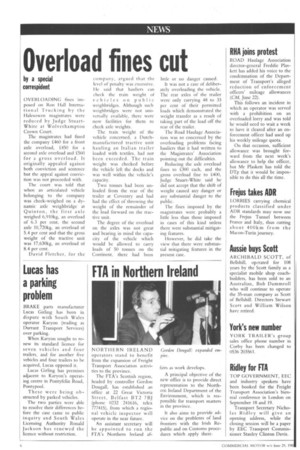Overload fines cut
Page 8

If you've noticed an error in this article please click here to report it so we can fix it.
by a special cortespident
OVERLOADING fines imposed on Ron Hall International Trucking by the Halesowen magistrates were reduced by Judge StuartWhite at Wolverhampton Crown Court.
The magistrates had fined the company £460 for a front axle overload, £450 for a second axle overload and £560 for a gross overload. It originally appealed against both conviction and sentence but the appeal against conviction was not proceeded with.
The court was told that when an articulated vehicle belonging to the company was check-weighed on a dynamic axle weighbridge at Quinton, the first axle weighed 6,910kg, an overload of 6.3 per cent, the second axle 10,720kg, an overload of 5.4 per cent and that the gross weight of the tractive unit was 17,630kg, an overload of 8.4 per cent.
David Fletcher, for the company, argued that the level of penalty was excessive. Ile said that hauliers can check the train weight of vehicles on public weighbridges. Although such weighbridges were not universally available, there were now facilities for them to check axle weights.
The train weight of the vehicle concerned, a Dutchmanufactured tractive unit hauling an Italian trailer loaded with textiles, had not been exceeded. The train weight was checked before the vehicle left the docks and was well within the vehicle's capacity.
Two tonnes had been unloaded from the rear of the trailer at Coventry and had had the effect of throwing the weight of the remainder of the load forward on the tractive unit.
The degree of the overload on the axles was not great and bearing in mind the capacity of the vehicle which would be allowed to carry loads of 50 tonnes on the Continent, there had been little or no danger caused.
It was not a case of deliberately overloading the vehicle. The rear axles of the trailer were only carrying 48 to 33 per cent of their permitted loads which demonstrated the weight transfer as a result of taking part of the load off the rear of the trailer.
The Road Haulage Association was so concerned by the overloading problems facing hauliers that it had written to the Magistrates' Association pointing out the difficulties.
Reducing the axle overload fines to £300 each, and the gross overload fine to £400, Judge Stuart-White said he did not accept that the shift of weight caused any danger or any substantial danger to the public.
The fines imposed by the magistrates were probably a little less than those imposed in cases of this kind unless there were substantial mitigating features.
However, he did take the view that there were substantial mitigating features in the present case.




































































































